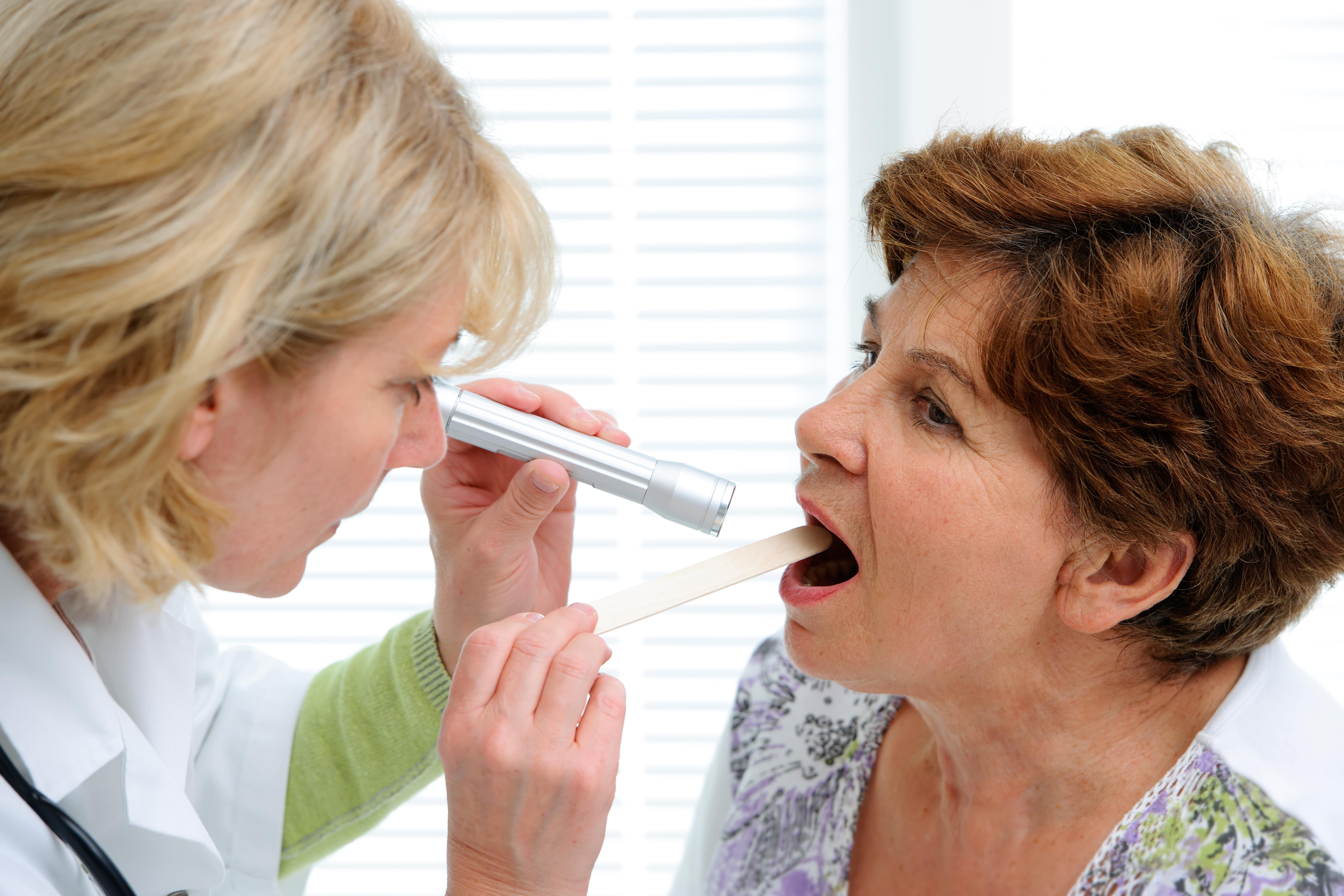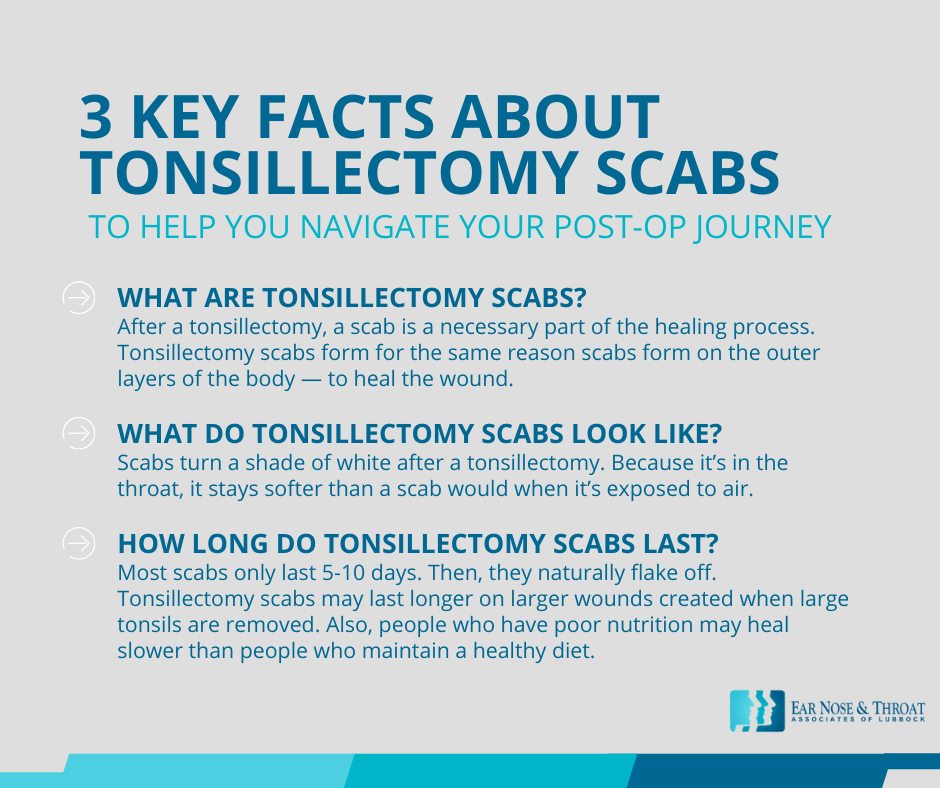Tonsillectomy Scabs: A Surgeon’s Post-Op Guide

Prepping for your tonsillectomy is easy, but thinking about recovery is a little more complicated. Among the primary concerns of patients following this procedure are the tonsillectomy scabs that will form as their throat heals.
To help you navigate your post-op tonsillectomy journey, we’ve answered the top 10 questions we hear about tonsillectomy scabs:
What are tonsillectomy scabs anyway? Are they inevitable?
After a tonsillectomy, a scab is a necessary part of the healing process. The scab forms a layer of inflammatory cells as part of our immune response to a wound.
Tonsillectomy scabs form for the same reason scabs form on the outer layers of the body — to heal the wound. It’s similar to what would happen if you had an abrasion on your knee. A scab would form and eventually come off. When the scab comes off, it might bleed. Similarly, when a scab forms in your throat and then comes off, it may cause some bleeding.
Usually, minor bleeding from tonsillectomy scabs is not a major problem. It’s just the way your body heals the wound.
What do tonsillectomy scabs look like?
Scabs turn a shade of white after a tonsillectomy. Because it’s in the throat, it stays softer than a scab would when it’s exposed to air. Typically, the whitish scab is made of a coagulum of many different kinds of cells.
Related: Adult Tonsillectomy: What To Expect & How to Prepare
How long do tonsillectomy scabs last?
Most scabs only last 5-10 days. Then, they naturally flake off.
Tonsillectomy scabs may last longer on larger wounds created when large tonsils are removed. Also, people who have poor nutrition may heal slower than people who maintain a healthy diet.

Can tonsils grow back?
While this may sound like a silly question, it’s actually legit.
Most ENT doctors completely remove the tonsils, including a surrounding capsule. However, there’s a different tonsil tissue on the base of your tongue called lingual tonsils. As the throat heals, the lingual tonsil can move into the lower area where the tonsil tissue was — and that’s what most people call a regrowth.
There is a less-popular technique of tonsil removal called sub-capsular dissection that purposefully leaves tonsil tissue behind. This method can lead to another form of tonsil regrowth.
While some regrowth is possible, tonsils will not completely return after a tonsillectomy.
Are tonsillectomy scabs painful?
Tonsillectomy scabs are not necessarily painful in their own right, but the healing process can be. The wound in the throat is uncomfortable as the body responds with inflammation and seeks to repair and re-cover nerve endings exposed in the procedure. This discomfort typically peaks around day seven after a tonsillectomy.
Will I see blood?
Most of the time, blood indicates the coagulum (or scab) has come off. When this happens, patients typically experience light bleeding. We recommend gargling ice water to constrict blood vessels and stop bleeding.
When should a patient call a doctor or visit the ER?
Post tonsillectomy bleeding can sometimes be severe. In these cases, it may be a small artery that’s bleeding (not the scabs). We consider bleeding severe when patients see enough bright red blood to fill a portion of a cup. If you experience a severe episode of bleeding, call your doctor immediately.
If bleeding happens once, it still may be a symptom of a scab separating from the throat. However, if severe bleeding happens twice, it’s likely an artery that’s bleeding.
If there are concerns about excessive bleeding, particularly if it happens twice, head to the emergency room. It’s always a good idea to call your ENT on the way to alert them to the issue.
What helps tonsillectomy scabs heal faster?
Good hydration and healthy nutrition help your body heal optimally. However, a healthy diet can be difficult while on a post-op liquid diet. As much as possible, opt for nutritional foods and beverages that are still gentle on the throat.
Typically, adults need 6-8 glasses of water a day. A child needs 3-4 glasses. If urine is dark or infrequent, you need more water. Beverages with electrolytes can be helpful with hydration as well.
While on a liquid diet, don’t forget to consider the nutritional value of what you drink. Smoothies and broth-based soups can help provide your body with the nutrition it needs to support healthy healing.
Also, avoid smoking, which delays healing.
Is bad breath normal after a tonsillectomy?
Bad breath is a normal post-op symptom. As the body responds to the wound in the throat, it typically produces bad breath.
Do patients need antibiotics after a tonsillectomy?
Post-operative antibiotics have been a debated issue among ENTs. In the past, some studies showed these to be beneficial in decreasing fever and bad breath while increasing wound healing rates.
More current research shows antibiotics are not completely necessary after surgery. Consequently, most doctors have an individual recommendation based on their experience with patients and what typically produces the best results.
Related: The Top 3 Reasons You May Need to Remove Your Tonsils
After your tonsillectomy, scabs are an inevitable part of the healing process. However, with the right care, hydration, nutrition, and awareness, your body will heal and you’ll be fully recovered within two weeks.
Have any other questions? Give us a call and we’ll help you navigate your tonsillectomy.
Dr. Scolaro is a board-certified Otolaryngologist servicing the South Plains area. He has been practicing in Lubbock since 1990 and has earned a reputation as a skilled and experienced surgeon. He currently serves as the Medical Director for Covenant High Plains Surgery Center campuses, is a member of Covenant Health Partners and is an adjunct faculty professor for Texas Tech University Health Sciences Center School of Medicine. Learn more about Dr. Scolaro.
Categories:








